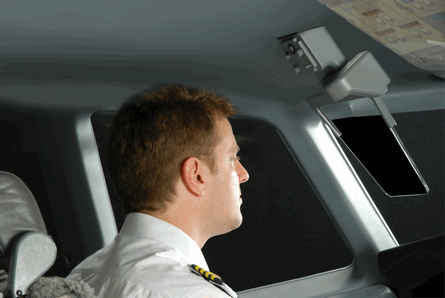BAE Systems’ new Q-HUD, unveiled at NBAA on Monday morning, is expected to make the head-up display (HUD) a more practical display option for business jets by solving cockpit space and weight challenges. This next-generation HUD is scheduled to enter service in 2010.
“Q-HUD is very radical, very disruptive, very different from any conventional display,” says Paul Childs, Q-HUD technology lead for BAE.
Ric Morrow, director of commercial avionics business development for the UK aerospace giant, adds: “Airline and military aircraft have used HUDs for the last couple decades. Now we can expand the technology to bizjets. With Q-HUD, business aviation has access to a HUD that will fit in the cabin.”
Unlike the traditional projection-style HUD positioned close above the pilot’s head, taking up cockpit real estate, Q-HUD eliminates the need for the overhead box by generating images within the HUD glass using holographic waveguides. Instead of shining an image on to the surface of a combiner from behind the pilot’s head, Q-HUD injects the image through the side of the glass.
 |
|---|
© BAE Systems |
By alleviating the need for projection, this unique design allows the unit to be mounted above the cockpit’s closeout, so the combiner is the only visible component of the system. In addition, the pilot’s head will not block the projected image – a problem that occurs with conventional HUDs.
While pilots will still see basically the same display, Morrow says Q-HUD is 50% smaller and lighter than traditional HUDs, providing increased head clearance and comfort in the cockpit. This space savings is the key that allows a HUD to be deployed into most sizes of business jets.
Additional advantages include economical price points for business aviation; weight reduction, compared to the heavy optics equipment of typical HUDs; and reduced power consumption and heat generation, further supporting comfort, particularly in smaller cabins.
“We were able to improve the technology and reduce space, weight and cost, and we didn’t have to compromise on performance or reliability,” Childs adds.
Q-HUD can integrate with enhanced or synthetic vision interfaces, and existing flight deck computational resources, potentially saving the cost of a separate display.
Although BAE has not secured a launch customer yet, the company is in discussions with several airframe manufacturers and Tier 1 suppliers. For now the company will focus on aircraft ranging from medium-sized business jets to jumbo passenger aircraft, but Morrow believes Q-HUD is a technology step that will take BAE toward the VLJ market as well.
To date, BAE has only manufactured HUDs for three civilian aircraft types - the Gulfstream GIV and GV and the Boeing 737-800 - but Morrow is still confident Q-HUD will gain wide acceptance.
“We have done some preliminary briefing with some very targeted audiences, and the technology has been very well received,” he says.
At NBAA, BAE will be demonstrating Q-HUD technology alongside Q-Sight, a helmet-mounted display launched by BAE last year for the military rotor wing sector. Q-HUD is an expansion of the technology pioneered on Q-Sight.
Source: Flight International




















